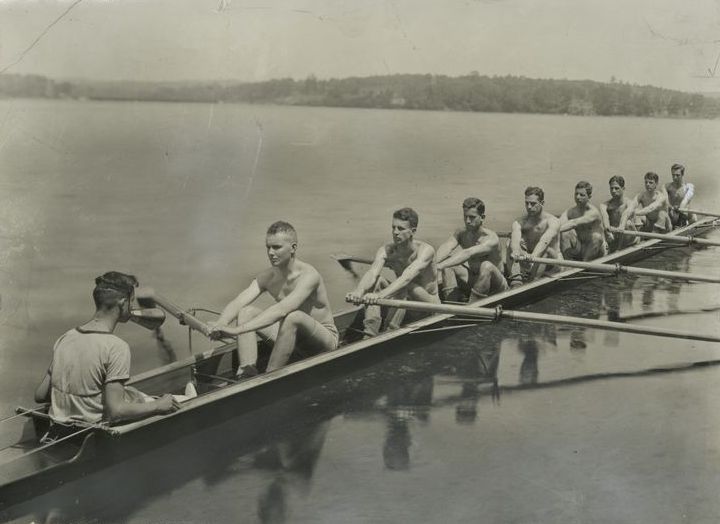CT Olympians rowing in the wake of history

The 1924 Yale Olympic rowing crew pictured practicing in Lake Housatonic in New Haven, located on the southern end of the Housatonic River.
New York Public Library

The 1924 Yale Olympic rowing crew pictured practicing in Lake Housatonic in New Haven, located on the southern end of the Housatonic River.
Connecticut will be represented by boat rowers in the upcoming ‘24 Paris Olympics.
That statement holds as much truth now as it did a century ago.
While Paris gets set to host the Olympic Games for the first time in 100 years, so too do boat rowers with roots in Connecticut prepare.
Oliver Bub from Westport, Liam Corrigan from Old Lyme, Kelsey Reelick from Brookfield, and Ben Washburn from Madison will each row in the 2024 Games. Team USA crews will also feature three alumni of Yale rowing: Margaret Hedeman, Kristi Wagner, and Mary Mazzio-Manson.
When the Olympic water contests begin July 27, these Connecticuters will row into the pages of history. The last time Paris hosted the Games in 1924, a Connecticut-based eight-man crew won gold. The “Yale Eight” won in dominant fashion, more than 15 seconds ahead of silver-medalist Canada.
The legendary 1924 crew included several noteworthy oarmen: James Stillman Rockefeller, great-nephew of John D. Rockefeller, attended the Taft School before going on to Yale; Leonard Carpenter, a graduate of The Hotchkiss School, went on to a successful career in the lumber industry; Benjamin Spock, famed pediatrician and author of “Baby and Child Care,” rowed in the seven-seat.
In the archives of the National Rowing Hall of Fame is a letter from Spock to Rusty Wailes, seven-seat in the gold-winning Yale crew of the 1956 Olympics. In the letter Spock shares his experience of the Parisian Games.
The 1924 Yale crew was delayed in departing for France due to a late-season race against Harvard. The team traveled by boat across the Atlantic and Spock recalled their journey: “Four rowing machines were screwed into the boat deck where one of the life boats was swung over the side and we had two hard workouts a day on the rowing machines in addition to doing calisthenics. Gloria Swanson was on board but was not in our party. Our captain [James Rockefeller] met his wife on the boat and between these two extremes various other possibilities were considered.”
Upon arriving at Olympic Village late, the crew found no available housing for them: “The only place we could get in were some huts right near the track and field stadium where we were with the extras of the various teams who had come in late. They were miserable quarters. Our nearest and dearest neighbors were Esthonian weight lifters. The beds were uncomfortable and the mosquitoes terrific. The representative of the Yale Rowing Committee, however, was very nearly murdered in trying to make us feel better by referring to the noise of the taxi horns outside his accommodations at the Ritz Hotel.”
A July 3, 1924, edition of The Lakeville Journal recounts a different arrival for the American athletes who made it on time to Paris:
“Police Hold Back Surging Throngs Around Olympic Stars
Paris — Trim, alert and eager to be up and doing, the American Olympic team arrived in Paris on two special trains from Cherbourg. They presented a fine spectacle as they descended from the trains, and groups of French fans who assembled out of curiosity broke into cheers of enthusiasm as the young Americans [section damaged] the quays to the wailing cars. All are reported in fine condition.”
Spock goes on to describe the medal race on the Seine River on a sweltering hot day just past where “the sewers emptied out.” He ultimately recalls winning gold and angering the French by refusing to attend a champagne party. He ends with words of encouragement for the 1956 team:
“Having seen your crew a week ago, however, it does not disturb me in the least to say that you must be a faster crew...Let me urge all of you to the extent that time permits to make a hobby of rowing.”
Yale crews went on to win gold in the 1956 Melbourne Games in both Men’s Eight and Men’s Pair.
A Parisian summer awaits the current generation of Olympian rowers from Connecticut. Supporters of the stars and stripes will do well to echo the urge of Spock that the 2024 oarsmen “make a hobby of rowing.”
Note: Connecticut will be represented by several non-rowers in the 2024 Olympics as well.
Runners line up at the starting line alongside Santa before the start of the 5th Annual North Canaan Santa Chase 5K on Saturday, Dec. 13.
NORTH CANAAN — Forty-eight runners braved frigid temperatures to participate in the 5th Annual North Canaan Santa Chase 5K Road Race on Saturday, Dec. 13.
Michael Mills, 45, of Goshen, led the pack with a time of 19 minutes, 15-seconds, averaging a 6:12-per-mile pace. Mills won the race for the third time and said he stays in shape by running with his daughter, a freshman at Lakeview High School in Litchfield.

Don Green, 64, of Red Hook, New York, was second among male runners with a time of 21:17 and a 6:52-per-mile pace. Becky Wilkinson, 47, of Southfield, Massachusetts, was the first woman to cross the finish line with a time of 22:16, averaging a 7:11-per-mile pace. Wilkinson finished fourth overall.
Margaret Banker, 52, of Lakeville, finished second among women runners with a time of 23:59 and a 7:44-per-mile pace.
Runners came from all over Connecticut, Massachusetts and New York. One runner listed home as London, England. Many were members of the Run 169 Towns Society, a group that is dedicated to completing races in every one of Connecticut’s 169 towns. Elizabeth Smith, 32, of Manchester, a member of Run 169, said this was her 162nd town.
“I started 10 years ago,” Smith said. Her husband, Daniel, 33, has run races in 73 Connecticut towns, now including North Canaan. He was eager to know where to get a good cup of coffee after the race.
Santa, who got a head start on the group of runners but finished next to last with a time of 44:14, has been a feature in the North Canaan race since it started five years ago.
The 5K proceeds from a start in front of the North Canaan Elementary School on Pease Street to course around the Town Hall parking lot, up West Main Street past the transfer station to the state line and back. Cheryl Ambrosi, 45, of Danbury, was the last to cross the finish line with her dog Benji. “It was so much fun,” she said as she ended, even though she didn’t catch Santa.

The Torrington Transfer Station, where the Northwest Resource Recovery Authority plans to expand operations using a $350,000 state grant.
TORRINGTON — The Northwest Resource Recovery Authority, a public entity formed this year to preserve municipal control over trash and recycling services in northwest Connecticut, has been awarded $350,000 in grant funds to develop and expand its operations.
The funding comes from the Department of Energy and Environmental Protection via its Sustainable Materials Management grant program. It is intended to help the NRRA establish operations at the Torrington Transfer Station as well as support regional education, transportation, hauler registration and partnerships with other authorities.
Founded by the City of Torrington in May 2025, the NRRA was established to oversee regional municipal solid waste management. Its creation followed a $3.25 million offer by USA Waste & Recycling to purchase the Torrington Transfer Station — a sale that would have privatized trash services in the region.
The proposed sale was initially approved by the MIRA Dissolution Authority, the entity responsible for dissolving the state’s former Materials Innovation and Recycling Authority, which owned the Transfer Station at the time. Before the transaction could close, the state intervened and directed that the facility’s operating permit be assigned to the NRRA to preserve a publicly controlled alternative.
MIRA has since dissolved, and the Transfer Station is currently operated by the state Department of Administrative Services. Many towns in northwest Connecticut have expressed interest in joining the NRRA. As of December, Torrington and Goshen were the only two municipalities in the authority.
At the Dec. 11 meeting of the Northwest Hills Council of Governments (COG) — a regional planning body representing 21 municipalities in northwest Connecticut — Director of Community and Economic Development Rista Malanca encouraged more towns to sign on.
“We need towns to join the Northwest Resource Recovery Authority to show your support, show this is what you want to do,” Malanca said.
Salisbury First Selectman Curtis Rand said his municipality is planning a town meeting in January to vote on a resolution to join the NRRA. Cornwall’s Board of Selectmen recently discussed scheduling a town meeting in the winter for the same purpose. Sharon, Falls Village and North Canaan have also expressed continued interest in pursuing a public option.
Kent is the northernmost member of the Housatonic Resource Recovery Authority, a regional solid waste authority representing 14 municipalities stretching south to Ridgefield. COG towns expressed interest in joining HRRA in 2024, but they were denied and set out to develop the NRRA.
“We also have been having conversations with the Capital Region Council of Governments and the Naugatuck Valley Council of Governments to think about how we can use existing resources, maybe some of these grant funds, to bring in shared resources or shared staffing that will help with some of the recycling coordinating efforts,” Malanca said.
With grant funds secured, NRRA aims to grow to a point that it can take over operations at Torrington Transfer Station to serve as a regional hauling hub. What happens to the trash after that has yet to be determined. Currently, it is being shipped to a landfill out of state. The existing municipal refuse hauling contracts that were established with the state expire in 2027.
The Salisbury Winter Sports Association (SWSA) will host its annual Junior Jump Camp, a two-day introduction to ski jumping, on Saturday and Sunday, Dec. 27 and 28, from 9 a.m. to 2 p.m. at Satre Hill in Salisbury.
The camp is open to children ages 7 and up and focuses on teaching the basics of ski jumping, with an emphasis on safety, balance and control, using SWSA’s smallest hill. No prior experience is required.
The cost is $50 per child and includes instruction and lunch on both days. For more information or to register, visit www.skireg.com/swsa-camp or email info@jumpfest.org
Jesse Bunce, first selectman of North Canaan.
LITCHFIELD — The Northwest Hills Council of Governments welcomed six newly elected municipal leaders Thursday, Dec. 11, at its first meeting following the 2025 municipal elections.
The council — a regional planning body representing 21 towns in northwest Connecticut — coordinates transportation, emergency planning, housing, economic development and other shared municipal services.
Barkhamsted First Selectman Meaghan Cook, Goshen First Selectman Seth Breakell, Kent First Selectman Eric Epstein, Norfolk First Selectman Henry Tirrell, North Canaan First Selectman Jesse Bunce and Torrington Mayor Molly Spino were each elected to their post in November.
They filled the seats of their predecessors on the COG, who were each given a toast of appreciation: Nick Lukiwsky (Barkhamsted), Todd Carusillo (Goshen), Marty Lindenmeyer (Kent), Matt Riiska (Norfolk), Brian Ohler (North Canaan) and Elinor Carbone (Torrington).
COG Executive Director Rob Phillips said the outgoing members were given a going away mug that read “You’re living the dream still.” Members voted to appoint Warren First Selectman Greg LaCava to fill a vacancy on the Council’s Executive Committee. COG members voted by paper ballot, and LaCava defeated Burlington First Selectman Doug Thompson for the vacant seat.